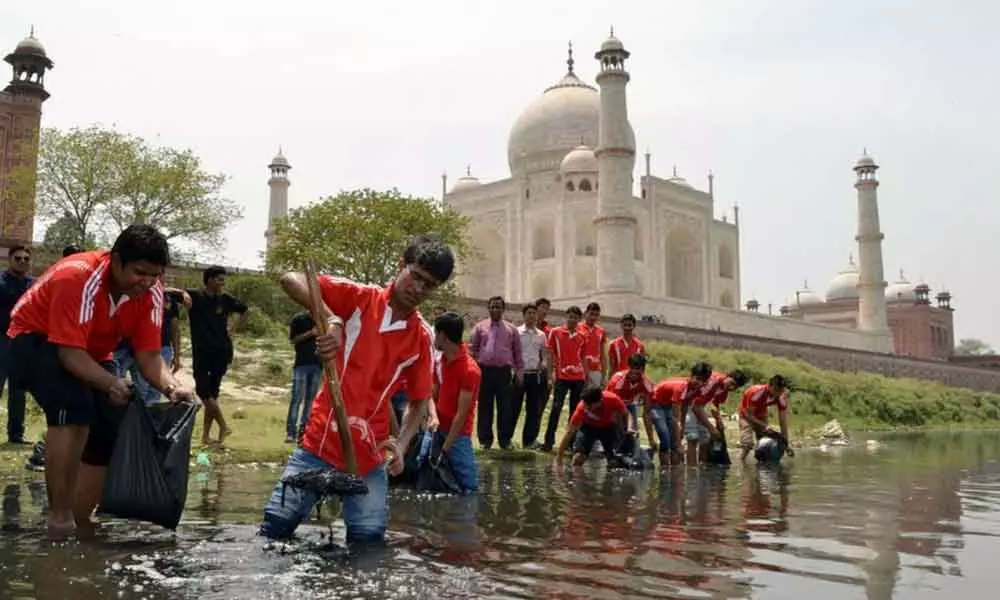Live
- 10 Maoists gunned down in encounter with security forces in Sukma
- K’taka parties keenly await bypoll results, spotlight on high-profile Channapatna
- Hyderabad Student Aryan Reddy Dies in Tragic Gun Misfire Accident on His Birthday in Atlanta
- Iraqi PM, Putin discuss regional situation, energy cooperation over phone
- Pushpa 2 Shooting Still Pending? Will It Release on Time?
- Can air pollution affect weight gain and hormonal health?
- Vishvaraj Singh Mewar's coronation ceremony in Chittorgarh on Nov 25
- KL Rahul’s Controversial Dismissal Sparks Debate in 1st Test at Perth
- Cricket Australia to honour late Philip Hughes on 10th anniversary
- Khushi Kapoor shines bright
Just In
Monuments dwarfed by encroachments


Monuments dwarfed by encroachments
Alhough Agra could not celebrate World Heritage Day on April 18 due to the Covid-19 pandemic restrictions, conservationists and green activists have...
Alhough Agra could not celebrate World Heritage Day on April 18 due to the Covid-19 pandemic restrictions, conservationists and green activists have once again highlighted the failure of the Archaeological Survey of India (ASI) to free the string of monuments in the city of encroachments that were seen as a major threat to the health and safety of these precious properties.
"The increasing visual pollution was another cause of concern," warned environmentalist Devashish Bhattacharya, adding that high-rise buildings coming up in all parts have gravely distorted the original ambience around several structures.
With three world heritage monuments and half a dozen other historical structures, Agra continues to remain India's number one tourist centre, drawing more than seven million visitors annually (before the pandemic). The local bodies however failed to restrict illegal constructions around these buildings, thus compromising the architectural integrity of the city, Bhattacharya added.
Almost all Mughal monuments here have now been dwarfed by encroachments. While restricting space and cluttering up and thus destroying the beauty of the historical buildings, these encroachments now have reached such levels of proliferation that the very survival of some monuments is at stake, said Shravan Kumar Singh of the Braj Mandal Heritage Conservation Society.
The Taj Mahal, surrounded by mohallas of the Taj Ganj locality, has been able to breathe easily because of the Supreme Court judgments seeking its conservation; international concern for its safety has also aided the cause of the preservation of the heritage monument.
Lesser monuments, however, have not experienced such luck.
The Delhi Gate, close to the Raja Mandi station, finds itself threatened by new constructions, mostly private nursing homes and garages that were not there before. Mughal emperor Akbar's deserted capital, the Fatehpur Sikri complex, continues to be threatened by the illegal activities of the mining mafia, which has been carrying on operations without fear, even though the Supreme Court has given a categorical directive to district authorities to stop mining in the area.
The pre-historic caves with paintings in the vicinity are under threat. If the Union Culture Ministry did not act fast, these could be lost to posterity, said Bhattacharya, who is leading a one-man crusade to protect these valuable assets.
The ASI has been regularly writing the district authorities to draw attention to the flagrant violation of the 1958 Ancient Monuments Act, but there has never been any positive response.
The ASI has circulated a list of about 50 monuments in Agra that come under the purview of the Monuments Protection Act. The Agra Development Authority (ADA) is responsible for ensuring there were no new constructions around these buildings.
ADA authorities, however, privately confess that demolition of all illegal structures was beyond their capacity. Political pressures would prevent any major offensive against encroachers.
The city of the Taj has numerous monuments which come under the protected list.
Over the years, because of governmental indifference and corrupt practices, no action has been taken against people who built houses and places of worship around these monuments.
The Roman Catholic cemetery near the Civil Court is now surrounded by a movie hall, a petrol pump and a shopping complex.
Other historical buildings or remnants like Jodhabai'sChatri, Jaswant Singh kiChatri, Chini ka Roza, Humayun's mosque, Mariam's tomb, Babar's Ram Bagh, Barahkhambha, and scores of other valuable architectural pieces are under threat, as encroachments creep up on every inch of space.
Some of the dilapidated landmarks are being used as cowsheds, or as havens for anti-social elements. The Yamuna floodplains that nourished and provided the natural ambience had been encroached upon all over.
"It's been almost a decade that the National Green Tribunal, hearing a petition on this, had come out with a clear cut verdict. The situation is the same in Mathura and Vrindavan, where the river banks are under threat from encroachers," said Jagan Nath Poddar, convener of the Friends of Vrindavan.
One wonders what happened to the newly constituted National Monuments Authority (NMA) which was mandated to come down heavily on illegal structures near protected monuments, said Surendra Sharma, president of the Heritage Conservation Society and a senior hotelier of Agra.

© 2024 Hyderabad Media House Limited/The Hans India. All rights reserved. Powered by hocalwire.com






